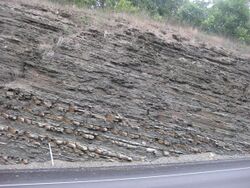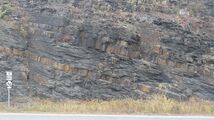Earth:Brallier Formation
| Brallier Formation Stratigraphic range: Frasnian - Famennian[1] | |
|---|---|
 Outcrop of Brallier Formation on north side of Pennsylvania Turnpike, central Bedford County, near Mile Marker 138 | |
| Type | sedimentary |
| Sub-units | Black Creek Siltstone Member,[2] Minnehaha Springs Member[3] |
| Underlies | Greenland Gap Group and Scherr Formation |
| Overlies | Harrell Formation |
| Thickness | 1350 to 1800 feet in central PA[4] |
| Lithology | |
| Primary | shale, sandstone |
| Location | |
| Region | Appalachian Mountains |
| Country | United States |
| Extent | Maryland, Pennsylvania, Virginia, and West Virginia |
| Type section | |
| Named by | Charles Butts, 1918[4] |
The Devonian Brallier Formation is a mapped bedrock unit in Pennsylvania, Maryland, West Virginia, and Virginia.
Description
The Brallier Formation was described by Charles Butts in 1918 as a fine-grained, siliceous shale with few fine-grained sandstone layers, from outcrops in central Pennsylvania. Others expanded usage of the term to rocks in other states.
Stratigraphy
The Brallier is roughly equivalent to the Scherr Formation.
The contact with the underlying Harrell Formation is generally gradational.
Fossils
Hasson and Dennison reported the following fossils from outcrops of the lower Brallier at Keyser, West Virginia, Ridgeville, West Virginia, and McCoole, Maryland:[5]
- Bivalvia: Buchiola retrostriata, Paracardium doris, Pterochaenia fragilis
- Cephalopoda: Bactrites, Orthoceras filosum
- Cricoconarida (class of Mollusca): Styliolina fissurella
- Annelida: Pteridichnites biseriatus
Notable Exposures
Type locality is at a railway station 6 miles northeast of Everett, Bedford County, Pennsylvania.[4]
A large exposure is located in Huntingdon, Pennsylvania, along the ramp from U.S. Route 22 west to Route 26 north.[6]
Another good exposure is on the Pennsylvania Railroad bed just west of Altoona, Pennsylvania.[6]
Age
Relative age dating places the Brallier in the late Devonian.
References
- ↑ Paleozoic Sedimentary Successions of the Virginia Valley & Ridge and Plateau
- ↑ Avary, K.L., and Dennison, J.M., 1980, Back Creek Siltstone Member of Devonian Brallier Formation in Virginia and West Virginia: Southeastern Geology, v. 21, no. 2, p. 121-153.
- ↑ Lyke, W.L., 1986, The stratigraphy, paleogeography, depositional environment, faunal communities, and general petrology of the Minnehaha Springs Member of the Scherr Formation: Southeastern Geology, v. 26, no. 3, p. 173-192.
- ↑ 4.0 4.1 4.2 Butts, Charles, 1918, Geologic section of Blair and Huntingdon Counties, central Pennsylvania: American Journal of Science, 4th series, v. 46, p. 523-537.
- ↑ Hasson, Kenneth O., and Dennison, John M., 1978, STRATIGRAPHY OF THE DEVONIAN HARRELL AND MILLBORO SHALES IN PARTS OF PENNSYLVANIA, MARYLAND, WEST VIRGINIA, AND VIRGINIA, Project Final Report for Energy Research and Development Administration Contract #EY-77-C-21-8153, May 1978 [1]
- ↑ 6.0 6.1 Charles Butts, 1945. Hollidaysburg-Huntingdon folio, Pennsylvania, Folios of the Geologic Atlas 227. United States Geological Survey.
 |



